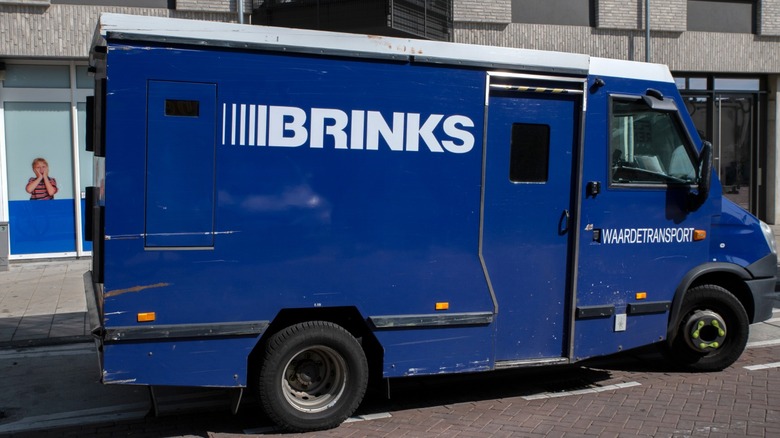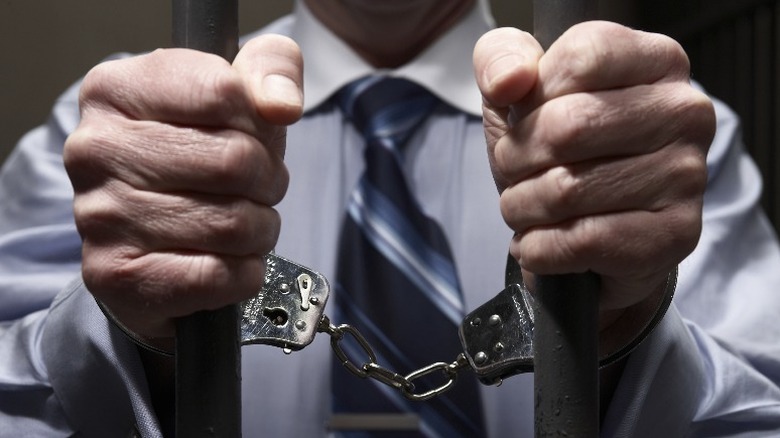The 1950 Robbery Of Brinks Inc. In Massachusetts Was Almost The Perfect Crime
The "big heist" has been a plot device for numerous films, books, and even video games in pop culture. The excitement that surrounds a group of career criminals joining forces to steal massive amounts of valuables from a central location has proven to be quite tangible. One of the most successful heist films produced was the 2001 smash hit "Ocean's Eleven" which, in combination with its three sequels, would generate nearly $1.5 billion in worldwide box office receipts (per The Numbers).
Whether it's a group of organized professionals knocking off a casino or a rag-tag band of hoodlums seeking a big score in the Diamond District, selling the heist to media-hungry consumers has been a good commodity. But reality is stranger than fiction, if not more interesting at times. While big heists are a rarity in the criminal world, there have been some large hauls that have gone unsolved for decades. The Belfast Bank robbery netted thieves more than $50 million in 2004, and the 2008 heist at a private Zurich museum resulted in paintings worth an estimated $163 million being stolen (via Forensic Yard).
One major heist that almost went unsolved happened in the United States more than 70 years ago. The planning, execution, and investigation were all so intriguing that the Boston Brinks heist of 1950 was the subject of multiple books and four feature films. It's been referred to as "the crime of the century" by the FBI, its perpetrators nearly slipping through the fingers of the law (via FBI).
The heist netted nearly $3M in cash and securities
Near 7:30 on the evening of January 17, 1950, a group of men entered the Brinks Armored Car Depot in Boston soon after the company's trucks had unloaded bags of cash for storage (via FBI). Eyewitness accounts vary, but the small gang of invaders numbered between five and seven, dressed in long pea coats, chauffeur's caps, and rubber Halloween masks.
The armed men had let themselves in with copies of keys that had been made earlier (per History). After forcing the employees onto the floor at gunpoint, the masked men tied their captives and sealed their mouths with adhesive tape. They then went to work loading $1.2 million in cash and $1.5 million in securities and checks into 14 canvas bags. Within 30 minutes, the team was out the door with their haul and fleeing in a getaway vehicle.
The FBI reports that the timing and movement of the perpetrators indicate that this was a job that was well-planned and well-rehearsed. The thieves left scant clues behind, departing the scene without the rope and adhesive tape they brought in with them and one of the chauffeur's caps. Thankfully, no one was killed or injured in the heist. But without much to go on, investigators followed hundreds of leads to dead ends for years afterward. It wouldn't be until one of the men in the heist felt betrayed by the rest of his crew that all the pieces of the puzzle would finally fall into place.
The case is finally solved
Several years after the big heist, Joseph O'Keefe sat down with the FBI. The bitter criminal was sitting in a Massachusetts prison on a probation violation charge, living in fear for his life. Before being sent to serve his term, he had been the target of three separate hits orchestrated by former associates. As the discussion progressed, agents learned that O'Keefe was one of 11 men who planned and carried out the Brinks heist. Several of his accomplices had turned against him, he felt, and his hopes of seeing his share of the haul were slim to none (via FBI).
O'Keefe began naming names and revealing how the heist took place. Over several years, the location had been studied and cased. At one point, several of the players made their way into the Brinks depot after employees had left for the day and removed the cylinders from five different door locks. They quickly had spare keys made for them, before returning and reinstalling the cylinders.
Just days before the statute of limitations was set to expire, the FBI arrested O'Keefe's cohorts. Of the 11, one had died the year before and a second man died before he could be brought to trial. The rest of the crew were all found guilty and sentenced to prison. All were eventually released on parole, save for one who died early into his prison term (via The Desert Sun).
History tells us that most of the money stolen was never recovered. It was almost the perfect crime, had it not been for the loose lips of one embittered crew member.


